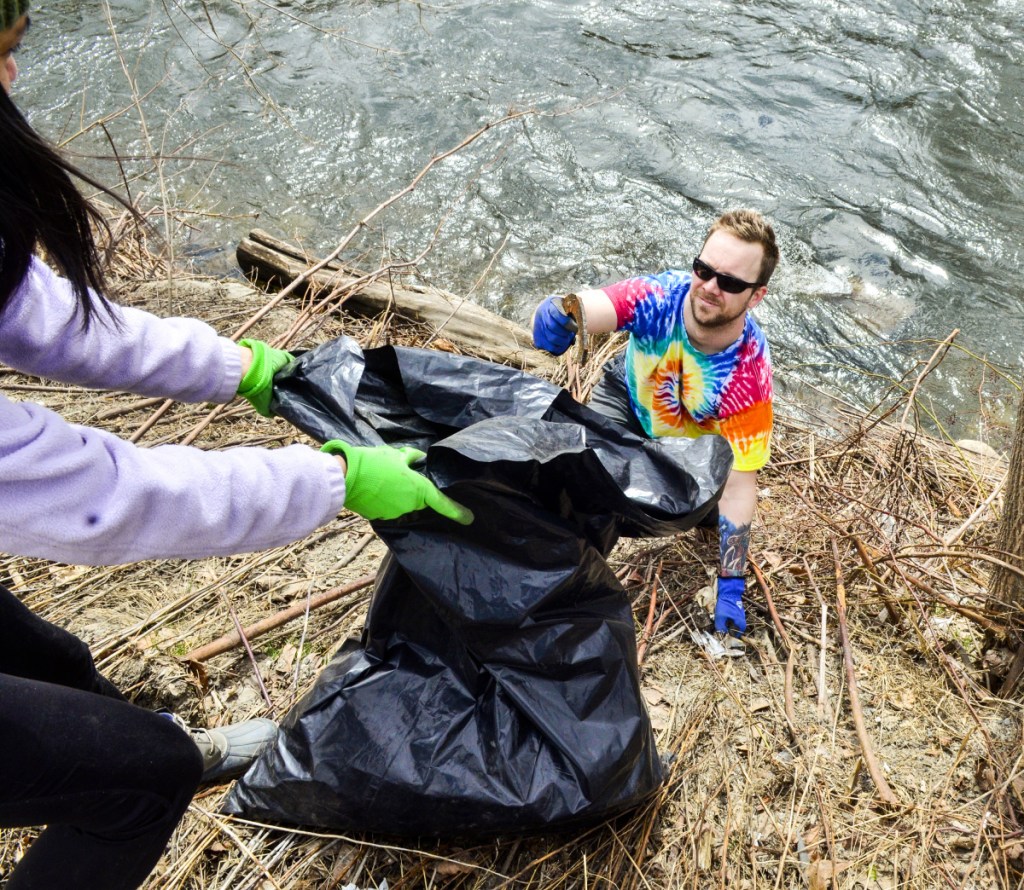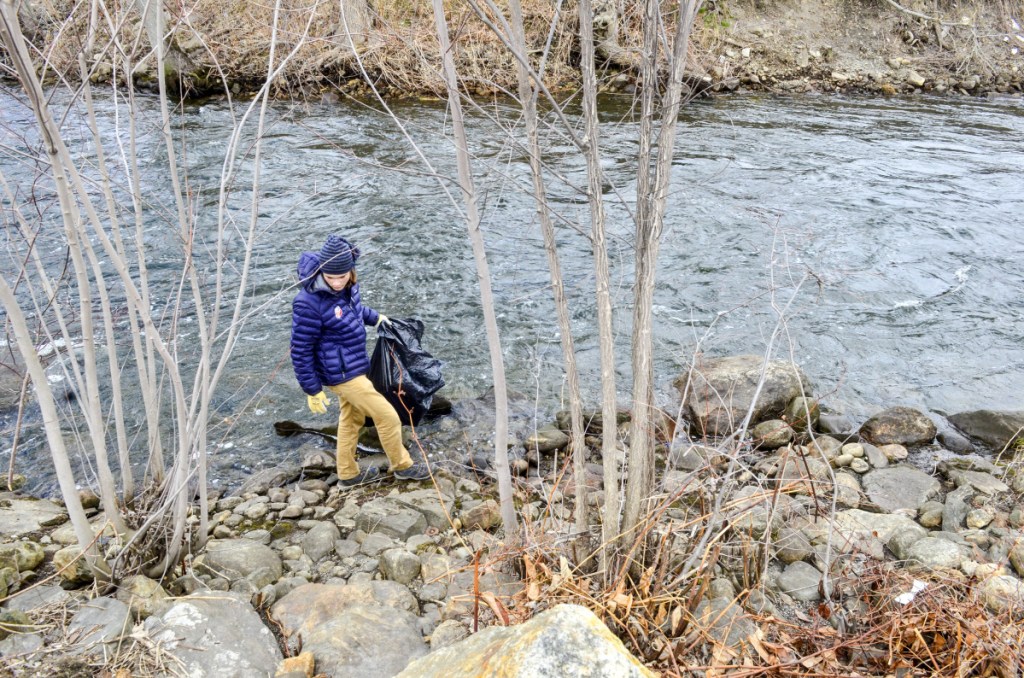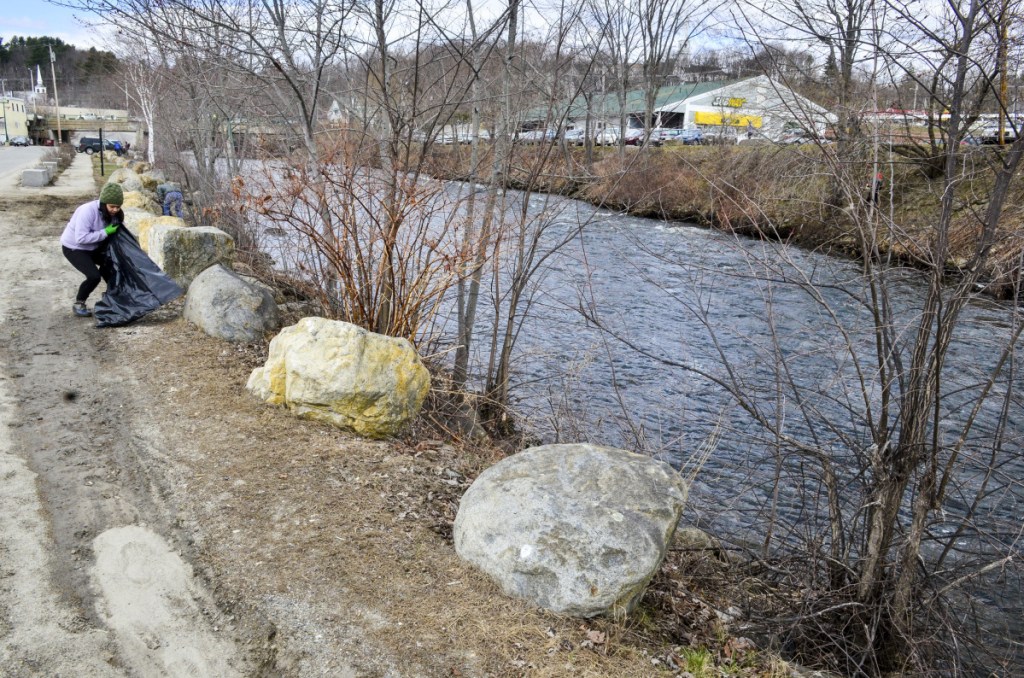GARDINER — When the napkin blew into the fast-moving water, Patrick Twombly did nearly everything he could on Saturday to snatch it back.
Standing on the steep north bank of Cobbosseecontee Stream, Twombly, 32, reached up to dump his handfuls of trash into a trash bag and asked for the grabber that Eileen Hagerman had thought to bring along. But when he turned to snatch the paper out of the water, the stream’s current had swept it just out of reach.
The thing he didn’t do was jump into the cold water after it.
While that napkin got away, Twombly, Hagerman and about two dozen other people poked along both sides of the stream banks between the Bridge Street and Maine Avenue bridges Saturday, picking up scraps of plastic and paper, pieces of styrofoam, straws, cans, cups, nip bottles, cigarette butts, losing scratch lottery tickets, a dollar, a shovel caked in asphalt, a computer tower, nicotine toothpicks, bits of fishing line and netting and whatever else they could reach that didn’t belong where it was.
They heeded the call of Upstream, a nonprofit in Gardiner that’s working to restore fish passage to Cobbosseecontee Stream, and of World Fish Migration Day to call attention to the waterway and to pick up the trash along the stretch that runs through downtown Gardiner, right before it flows into the Kennebec River and out to the Atlantic Ocean.
Promoted by the World Fish Migration Foundation, the day is intended to increase understanding of the importance of migratory fish, the need for healthy river systems and connecting them to the communities that depend on both of them.
The Gardiner observance was one of 10 events scheduled in Maine, including a scheduled walk at Presumpscot Falls in Falmouth, a celebration of the Sheepscot River in Whitefield and a 5K Spawning Run in Orono.
Maine’s coastal waterways are home to a number of migrating fish species, including the endangered Atlantic salmon, American shad, shortnose sturgeon, rainbow smelt and striped bass.
The season for harvesting elvers — the very young eels that make their way from the ocean to fresh water where they will spend their lives until returning to the ocean to spawn — is well underway. In about a month, river herring — both alewives and blueback herring — will start to return to fresh water to spawn.
In Maine, many of the waterways the migrating fish use started to be dammed up as long as two centuries ago, as the European settlers and their descendants used water to power their mills. At the same time, industrial processes and human settlement contributed to pollution in the state’s waterways that has taken years to clean up.
Saturday’s event in Gardiner started and ended with volunteers standing on the Bridge Street bridge and waving signs at passing traffic, before they marched in an informal parade down Water Street.
Hagerman, 36, showed up with a couple of ideas in mind.
One is the reports of whales that wash ashore with their stomachs filled with plastic.
“We wonder how those bits of plastic end up in the ocean, and they probably start here,” she said.
But closer to home, she said it’s about the identity of river communities such as Gardiner and helping to preserve their natural beauty and restoring fish passage.
What brought Charlie Caldwell, Caldwell said, were his parents. The 17-year-old Gardiner Area High School senior said he chose to come. His parents, Susan and Jim, are both environmentally active, and for all of the years of his life, they have been getting him into the outdoors.
“I am sort of ignoring the cigarette butts because there are too many of them for me to be efficient to grab,” Caldwell said. By that point, he had picked up a pizza box, a no-parking sign, cups, glass and a cool piece of a hubcap.
“I don’t know whether the alewives care as much about styrofoam on the shore as they do for the dam upstream; but it feels good, though,” he said.
Dan Auclair, 71, who with his wife returned to Maine after spending most of their lives on the West Coast, decided he would pick up at least some of the many cigarette butts he saw. He said he’s been working with Upstream for a while and he’s interested in fish restoration.
“It will look a lot better when we’re done here,” he said, and he planned to stick it out until the event wrapped up with an impromptu parade down Water Street at noon.
In addition to Saturday’s cleanup, Monkitree, a Water Street gallery, is hosting an exhibit, “Together is Better: The Marvel and Mystery of Fish Migration,” which opened Friday and continues through June 16.
For Tina Wood, a Gardiner resident who has been working with other Upstream members to restore fish passage on Cobbosseecontee Stream, the cleanup is just one step toward the larger goal. For the last several years, she has promoted art projects and public talks to bring attention to her cause, and that will continue with the Art Extravaganza, planned for May, where community members of all ages can come to the Gardiner Area High school to paint fish and build sculptures that will be displayed in that month on Gardiner sidewalks.
At the close of Saturday’s event, Wood said she was pleased with how the day turned out.
About nine bags of trash were collected, and the cast of volunteers included people who had never come to an Upstream event before.
“They are really interested and will help grow our base and get people involved in our projects,” Wood said.
“I felt really happy about it.”
Jessica Lowell — 621-5632
Twitter: @JLowellKJ
Send questions/comments to the editors.





Success. Please wait for the page to reload. If the page does not reload within 5 seconds, please refresh the page.
Enter your email and password to access comments.
Hi, to comment on stories you must . This profile is in addition to your subscription and website login.
Already have a commenting profile? .
Invalid username/password.
Please check your email to confirm and complete your registration.
Only subscribers are eligible to post comments. Please subscribe or login first for digital access. Here’s why.
Use the form below to reset your password. When you've submitted your account email, we will send an email with a reset code.